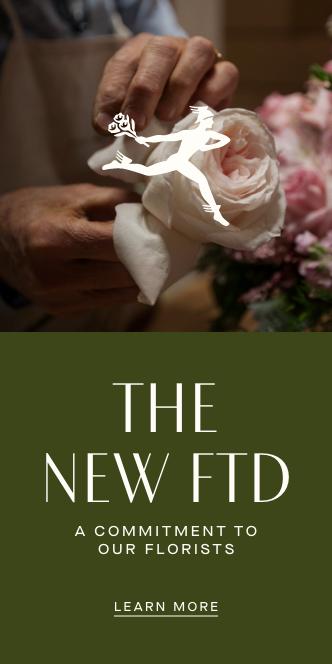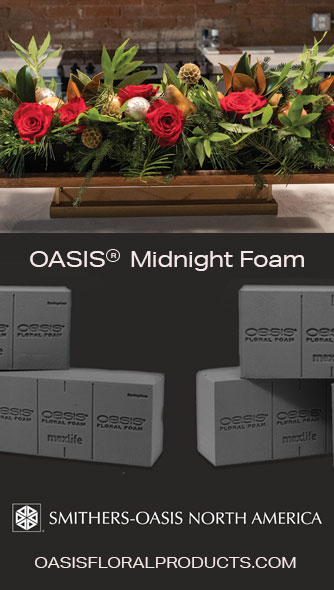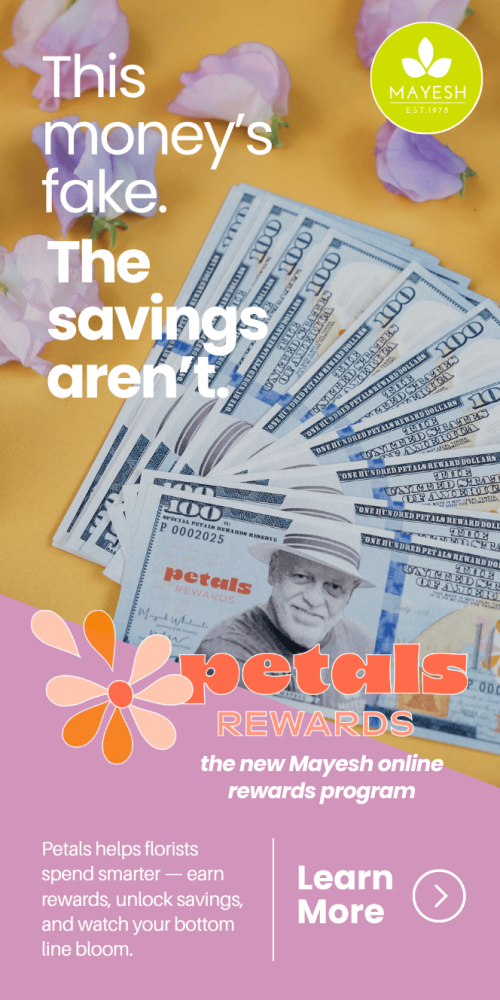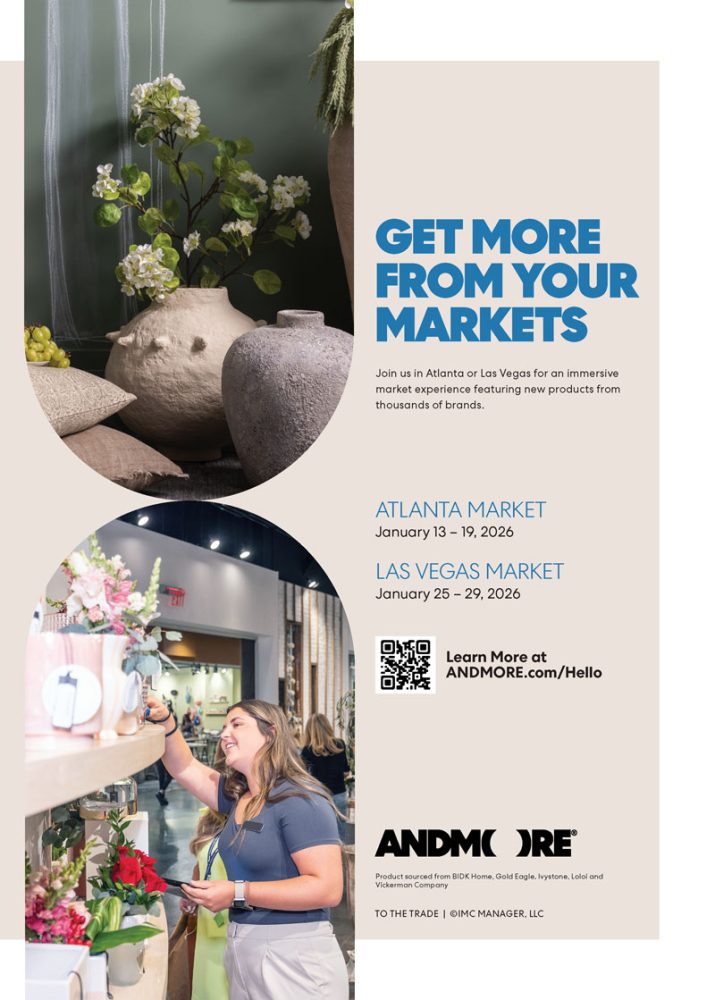These florists inspire us to adopt more eco-friendly and sustainable practices for wedding designs.
By Kat Castagnoli, AIFD
As floral designers know, flowers can have a huge impact on a wedding in the best way. But did you know those same gorgeous blooms can be a detriment to the environment? From the large amount of water and pesticides used to grow them to the quantity of waste produced from their disposal afterwards, wedding flowers and their components are a surprisingly significant contributor to environmental pollution and one’s carbon footprint.
The use of floral foam—a longtime staple of practically every florist—has become one of the biggest concerns, according to research from the Sustainable Floristry Network (SFN), an Australia-based independent education and membership organization that strives to create a more sustainable, nature-positive florist industry. Each floral foam brick contains roughly the same amount of plastic as 10 plastic bags, according to the SFN. When foam breaks down and the water from it is poured down the drain, it releases tiny plastic particles called microplastics, which contaminate our water systems and soil.
It’s worth mentioning—before we go further—that the terms “environmentally friendly,” “eco-friendly” and “sustainable” often get used interchangeably when technically they are different. In general, these closely related terms refer to minimizing harm or damage to, and even helping, our planet and its environment. But to clarify: “environmentally friendly” and “eco-friendly” more specifically pertain to reducing the production of waste, reusing, recycling, composting, safe disposal and biodegradability. “Sustainable” refers to avoiding or minimizing the depletion of natural resources and even replenishing or regenerating those that are used.
Molly Culver, of Molly Oliver Flowers in Brooklyn, N.Y., has given our planet a great deal of thought. “Going the sustainable route in floristry is a way of honoring and protecting the soil, water and ecosystems that co-produce the flowers we love and rely on for our livelihoods,” she says. “I believe change has to come from the ground up.”

Culver, who runs a “green” flower studio that specializes in weddings and events, says when she first began dabbling in floral design, she noticed there was a lack of options for couples seeking eco-friendly approaches to wedding flowers. “When I started my business in 2012, I knew I would invest in products grown and produced with sustainability in mind and attempt to build systems that created as little waste as possible,” she explains. “Our [environmentally friendly] approach has been built into everything we do since day one.”
This includes sourcing locally or domestically grown flowers; using reusable, foam-free mechanics like flower frogs, chicken wire and water tubes; curating a diverse inventory of vessels that can be reused after each event; and rethinking her studio’s waste management practices. “We made an arrangement with a local urban farm in 2013, and we’ve composted nearly 100 percent of our organic waste ever since,” adds Culver. “Our clients love this about our business and feel great knowing we are not sending a ton of unnecessary waste to landfills.”
Exploring Alternatives
Designing wedding bouquets or centerpieces in an eco-conscious way doesn’t mean compromising creativity or client expectations, according to TJ McGrath, of TJ McGrath Design in Plainfield, N.J.
“I always try to sell a vision to my clients that can be executed in water, in some way, shape or form,” says McGrath, who takes pride in sustainably showcasing New Jersey-grown flowers for bespoke weddings and other events. “I’m referencing elevated designs here, and I just don’t see a reason to not figure out a way to sell something you can achieve foam-free.”
McGrath says when he must create an installation for a wedding, a hanging design for example, and a water source is near impossible, “I design it to consist of materials that can handle minimal water and incorporate a mix of mechanics.” Some of these mechanics include reusable chicken wire inside of containers or as an armature or base for bouquet designs; chicken wire “sausages or burritos” rolled with grasses, moss or inexpensive greens to design into for arch and hanging pieces; tension stem grids or knotted branch “nests” or compostable alternatives, like New Age Floral’s biodegradable OshunPouch, AgraWool’s Sideau biodegradable floral foam and Phoam Labs’ bio-based Phoam floral foam.

Of note, Smithers-Oasis—creator of the industry standard floral foam—is also making strides in a marketplace clamoring for more sustainable options. According to president and CEO, Robin Kilbride, AAF, the company, which invented floral foam in 1954, has felt a responsibility to reinvent it as new raw materials have become readily available. “Our global research team has been pursuing this project for many, many years,” she says. OASIS® Renewal™ Floral Foam, a new plant-based alternative that boasts a 56 percent carbon footprint reduction, recently launched and will be available for purchase later this year.
McGrath explains that when he opened his flower business, he committed to finding substitutions to traditional floral foam. “All that has done is force me to be creative, sharpen my communication skills and find alternative ways of doing things,” he says. In fact, he has become an example for other florists on Instagram, with many reels showing him using alternative mechanics like chicken wire while designing.
“The hard decision was deciding to share openly on social media everything I was learning about the industry, but I felt really strongly that it had to be shared,” McGrath adds. “Now that I knew more and knew better, I absolutely had to try to do better, even if that meant failure.”

As you can see, more and more companies, including the institutions that are the backbone of our industry, are developing innovative products that address the concerns of environmentally conscious florists and consumers. Today, florists have more choices of design mechanics than ever, and the innovation is sure to continue.
Coaxing Change
According to Sheilan Mueller, of Yarrow & Spruce in Denver, the sustainability conversation in floristry has often felt intimidating. “Some spaces focused on ‘calling out’ rather than ‘calling in,’ and we wanted to shift that narrative,” she says. The “we” Mueller refers to includes two other environmentally conscious floral designers: Emma Van Vranken, of Emma Lea Floral in Golden, Colo., and Kim Zimmerman, of Rowdy Poppy in Denver.

Over coffee and continued conversation, the Colorado-based trio created the Sustainable Florist Club—a community built on collaboration, support and education. “Our goal is to create a welcoming space where florists can explore sustainability at their own pace and feel empowered to make meaningful changes,” Mueller explains.

Van Vranken echoes this sentiment, noting that her own transition into sustainability started small by designing away from floral foam and seeking out locally grown flowers. “The more I learned about our industry and the impacts of our choices as designers, the more invested I became in making my business intentionally sustainable, rather than just casually adopting some sustainable practices,” she says.
Zimmerman adds: “I don’t know what it’s like to design a wedding non-sustainably, to be quite honest. Yes, I was trained in school using floral foam, but I never used it in my business. Because I started out trying to set the right habits and processes for sustainability, it feels easy and natural to do it this way.”

Courtney Pino, of Abby Garden (AG) in Scarborough, Maine, agrees. She says it’s a lot simpler today to execute more sustainable wedding designs. “It’s a muscle that takes time and practice to develop and flex, but now it just feels natural and intuitive.”

Her best tip? Collect different mechanics (like chicken wire, water tubes, etc.) and multiple vessels that you can rent on repeat. This will drive your profit while you pivot to more sustainable practices.
“This will give you more income to purchase expensive materials like flower frogs or pay for labor to disassemble designs for compost and reuse,” says Pino, whose award-winning New England event studio specializes in flowers for fine-art weddings.
“We want to mitigate how much is disposed of in an anaerobic environment, which means no single-use materials [like zip ties],” explains Pino. “It may seem inconsequential, but there is a (slow!) snowball effect. As a more sustainable florist, we have reduced our landfill contributions by over 80 percent!”
Community Connections
For Holly Lukasiewicz, of District 2 Floral Studio in Omaha, Neb., creating beautiful wedding designs while prioritizing eco-friendly practices—such as abandoning the use of synthetically bleached, dyed, glittered or painted botanicals—has become a holistic practice, both personally and professionally.
“My motivation while creating is in offering my community meaningful moments of beauty and connecting them to nature through as low waste means as possible,” says Lukasiewicz. “It is an inner-connected, soul-level practice for me that feels honest.”

Inspired by reading Robin Wall Kimmerer’s book, Braiding Sweetgrass, which explores Indigenous wisdom gleaned from the natural world, Lukasiewicz has seen how sourcing flowers locally offers a mutually symbiotic relationship for people, the planet and the local economy in the following ways:
- Environmental sustainability: Locally grown, cut flowers require fewer resources, less fossil fuel and less packaging and refrigeration lengths—reducing transport time, biocide usage and plastic. Many local farms also practice regenerative methods, including no-till and no-spray techniques.
- Social sustainability: Lukasiewicz says sourcing flowers locally allows her to build relationships with flower farmers who care deeply about sustainable practices and the challenges of growing in Midwest weather patterns impacted by climate change. Additionally, a portion of District 2 Floral Design sales are shared with the Honor Native Land Fund to support regional Indigenous land restoration.
- Economic sustainability: Supporting these local flower farms keeps money in the community, fostering their economic sustainability.
“The industry at its core relies on healthy Earth ecosystems for abundance with which to create,” says Lukasiewicz. “I think it’s our responsibility to practice reciprocity when working with gifts from the Earth and to approach a design and business mentality with more empathy and kindness toward people and the planet.”
Tips for Going Green
For florists looking to adopt greener practices, check out these suggestions:
- Try alternatives to traditional floral foams. For centerpieces, try using chicken wire, colored aluminum wire, flower frogs or kenzans. Curly willow branches and grapevine can work like chicken wire—if sourced when supple, they will dry into sturdy structures to support your designs. Even edible mushrooms like snow fungus (Tremella fuciformis) will absorb water and form a dense, weighty cushion to design flowers into. Also consider Smithers-Oasis’ eco-friendly products, including OASIS® Renewal™ Floral Foam (brand new, and a game changer), FibreFloral™ Design Media and OASIS® TerraBrick™ Floral Media.
- Build an inventory of different vessels that you can reuse. This cuts down on a lot of unnecessary packaging, carbon emissions through the air and container shipping. You can add to or edit your collection over time to suit trends—or rent what you need from fellow florists! Less vessels in the world means less waste sent to the landfill.
- Use more product that doesn’t require a water source. You’d be surprised how many foliages, textures and even flowers hold up beautifully without a water source, even in dry climates or high heat. You may need to do some research and/or testing with this, but once you know which stems truly need hydration, you can often design large-scale pieces with just chicken wire, water tubes or a few well-placed water sources.
- Reduce packaging waste by replacing synthetic or single-use items with natural alternatives. For example, try natural fibers instead of ribbons and plant-based paper for cards. Eliminate plastic picks for bamboo, rose stems or branches. Swap plastic wraps with bio-based wraps and use naturally dried flowers instead of synthetically dyed, glittered or spray-painted flowers. Reuse packaging like flower boxes for transporting vessels and storage.
- Get to know your local flower farmers. Follow flower farms and flower collectives on Instagram, visit your local markets and build relationships with growers. Most industrially grown flowers use chemical-based pesticides and herbicides that put the long-term health of farm workers and the environment at risk. Get to know what flowers are grown seasonally in your location. Many designers even source flowers from their own gardens or those of their wedding clients. If you don’t have any flower farms nearby, connect with your wholesale representative and ask them to help you source locally or U.S.-grown flowers.
“There’s so much joy in working with flowers,” says Mueller. “I believe that joy should extend beyond the final design—to the people growing them, the florists designing with them and the couples celebrating [with] them.
By embracing more sustainable techniques, we have the power to create beauty in a way that feels good from start to finish.”
Free Resources and Guides Available
Established in 2022 by the American Floral Endowment, Sustainabloom is an initiative that supports floriculture research and communication around increased sustainable practices throughout the industry by creating user-friendly guides and resources. These resources are broken down by topic, allowing businesses to assess where they are and where they can do more.
With practical guides and easy-to-understand solutions, Sustainabloom supports florists in adopting more environmentally-sound practices, from composting floral waste to reducing plastic packaging and conserving water. Its website offers tools to assess where your business stands and how to improve sustainability efforts.
Learn more at sustainabloom.org.

























